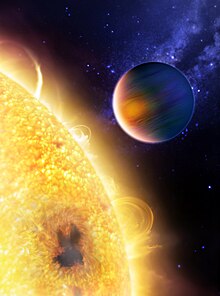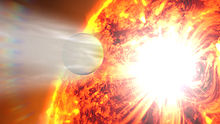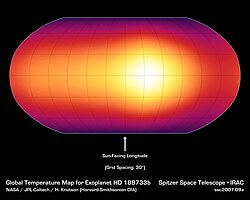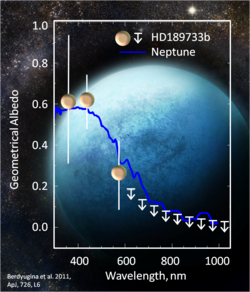HD 189733 b: Difference between revisions
No edit summary |
|||
| Line 64: | Line 64: | ||
{{Planetbox end}} |
{{Planetbox end}} |
||
'''HD 189733 b''', more formally '''HD 189733 Ab'''{{citation needed|reason=No evidence for this being "more formal", or even that the designation "HD 189733 Ab" is actually used by reliable sources|date=July 2013}}, is an [[extrasolar planet]] approximately 63 [[light-year]]s away from the [[Solar System]] in the [[constellation]] of [[Vulpecula]], the [[Fox]]. The planet was discovered orbiting the star [[HD 189733|HD 189733 A]] on October 5, 2005, when astronomers in [[France]] observed the planet [[Astronomical transit|transiting]] across the face of the star.<ref name="Bouchy2005"/> HD 189733 b was the first extrasolar planet for which a [[heat map|thermal map]] was constructed,<ref name="Berdyugina2011"/> to be detected through polarimetry, to have its overall colour determined (deep blue),<ref name="Berdyugina2011"/><ref name=kramer-2013>{{cite news | url=http://www.space.com/21928-alien-planet-blue-color-revealed.html | title=Strange Blue World: Alien Planet's True Color Revealed, a First | work=Space.com | date=11 July 2013 | agency=TechMediaNetwork | accessdate=11 July 2013 | author=Kramer, Miriam}}</ref> to have a transit detected in x-ray spectrum and to have [[carbon dioxide]] in its atmosphere. With a mass 13% higher than that of [[Jupiter]], HD 189733 b orbits its host star once every 2.2 days at an [[orbital speed]] of {{convert|152.5|km/s|mi/h}}, making it a [[hot Jupiter]] with poor prospects for [[extraterrestrial life|life as we know it]]. |
'''HD 189733 b''', more formally '''HD 189733 Ab'''{{citation needed|reason=No evidence for this being "more formal", or even that the designation "HD 189733 Ab" is actually used by reliable sources|date=July 2013}}, is an [[extrasolar planet]] approximately 63 [[light-year]]s away from the [[Solar System]] in the [[constellation]] of [[Vulpecula]], the [[Fox]]. The planet was discovered orbiting the star [[HD 189733|HD 189733 A]] on October 5, 2005, when astronomers in [[France]] observed the planet [[Astronomical transit|transiting]] across the face of the star.<ref name="Bouchy2005"/> HD 189733 b was the first extrasolar planet for which a [[heat map|thermal map]] was constructed,<ref name="Berdyugina2011"/> to be detected through [[polarimetry]], to have its overall colour determined (deep blue),<ref name="Berdyugina2011"/><ref name=kramer-2013>{{cite news | url=http://www.space.com/21928-alien-planet-blue-color-revealed.html | title=Strange Blue World: Alien Planet's True Color Revealed, a First | work=Space.com | date=11 July 2013 | agency=TechMediaNetwork | accessdate=11 July 2013 | author=Kramer, Miriam}}</ref> to have a transit detected in x-ray spectrum and to have [[carbon dioxide]] in its atmosphere. With a mass 13% higher than that of [[Jupiter]], HD 189733 b orbits its host star once every 2.2 days at an [[orbital speed]] of {{convert|152.5|km/s|mi/h}}, making it a [[hot Jupiter]] with poor prospects for [[extraterrestrial life|life as we know it]]. |
||
== Detection and discovery == |
== Detection and discovery == |
||
Revision as of 05:58, 21 October 2013
Template:Planetbox begin Template:Planetbox image Template:Planetbox image Template:Planetbox star Template:Planetbox orbit Template:Planetbox character Template:Planetbox discovery Template:Planetbox reference Template:Planetbox end
HD 189733 b, more formally HD 189733 Ab[citation needed], is an extrasolar planet approximately 63 light-years away from the Solar System in the constellation of Vulpecula, the Fox. The planet was discovered orbiting the star HD 189733 A on October 5, 2005, when astronomers in France observed the planet transiting across the face of the star.[1] HD 189733 b was the first extrasolar planet for which a thermal map was constructed,[2] to be detected through polarimetry, to have its overall colour determined (deep blue),[2][3] to have a transit detected in x-ray spectrum and to have carbon dioxide in its atmosphere. With a mass 13% higher than that of Jupiter, HD 189733 b orbits its host star once every 2.2 days at an orbital speed of 152.5 kilometres per second (341,000 mph), making it a hot Jupiter with poor prospects for life as we know it.
Detection and discovery
Transit and Doppler spectroscopy
On October 6, 2005, a team of astronomers announced the discovery of transiting planet HD 189733 b. The planet was then detected using Doppler spectroscopy. Real-time radial velocity measurements detected the Rossiter–McLaughlin effect caused by the planet passing in front of its star before photometric measurements confirmed that the planet was transiting. In 2006, a team led by Drake Deming announced a detection of strong infrared thermal emission from the transiting extrasolar planet HD 189733 b, by measuring the flux decrement (decrease of total light) during its prominent secondary eclipse (when the planet passes behind the star).
The mass of the planet is estimated to be 13% larger than Jupiter's, with the planet completing an orbit around its host star every 2.2 days and an orbital speed of 152.5 km/s. It is occasionally referred to as HD 189733 Ab to distinguish it from the red dwarf star HD 189733 B, the secondary star in the same system.
Infrared spectrum
On February 21, 2007, NASA released news that the Spitzer Space Telescope had measured detailed spectra from both HD 189733 b and HD 209458 b.[4] The release came simultaneously with the public release of a new issue of Nature containing the first publication on the spectroscopic observation of the other exoplanet, HD 209458 b. A paper was submitted and published by the Astrophysical Journal Letters. The spectroscopic observations of HD 189733 b were led by Carl Grillmair of NASA's Spitzer Science Center.
Visible colour
In 2008, a team of astrophysicists managed to detect and monitor the planet's visible light using polarimetry, the first such success.[5] This result was further improved by the same team in 2011.[2] They found that the planet albedo is significantly larger in blue light than in the red, most probably due to Rayleigh scattering and molecular absorption in the red.[2] The blue colour of the planet was subsequently confirmed in 2013,[6] making HD 189733 the first planet to have its overall colour determined by two different techniques.
The blueness of the planet may be the result of Rayleigh scattering. In mid January 2008, spectral observation during the planet's transit using that model found that if molecular hydrogen exists, it would have an atmospheric pressure of 410 ± 30 mbar of 0.1564 solar radii. The Mie approximation model also found that there is a possible condensate in its atmosphere, magnesium silicate (MgSiO3) with a particle size of approximately 10−2 to 10−1 μm. Using both models, the planet's temperature would be between 1340 to 1540 K.[7] The Rayleigh effect is confirmed in other models,[8] and by the apparent lack of a cooler, shaded stratosphere below its outer atmosphere.
X-ray spectrum
In July 2013, NASA reported the first observations of planet transit studied in X-ray spectrum. It was found that the planet blocks three times as much x-rays than visible light.[9]
Evaporation
In March 2010, transit observations using HI Lyman-alpha found that this planet is evaporating at a rate of 1-100 gigagrams per second. This indication was found by detecting the extended exosphere of atomic hydrogen. HD 189733 b is the second planet after HD 209458 b for which atmospheric evaporation has been detected.[10]
Physical characteristics

This planet exhibits the largest photometric transit depth (amount of the parent star's light blocked) of any extrasolar planet so far observed, approximately 3%. The apparent longitude of ascending node of its orbit is 16 degrees +/- 8 away from north-south in our sky. It and HD 209458 b were the first two planets to be directly spectroscopically observed.[4] The parent stars of these two planets are the brightest transiting-planet host stars, so these planets will continue to receive the most attention by astronomers. Like most hot Jupiters, this planet is thought to be tidally locked to its parent star, meaning it has a permanent day and night.
The planet is not oblate, and has neither satellites with greater than 0.8 the radius of Earth nor a ring system like that of Saturn.[11]
The atmosphere was at first predicted "pL class", lacking a temperature-inversion stratosphere; like L dwarfs which lack titanium and vanadium oxides.[12] Follow-up measurements, tested against a stratospheric model, yielded inconclusive results.[13] Atmospheric condensates form a haze 1000 km above the surface as viewed in the infrared. A sunset viewed from that surface would be red.[14] Sodium and potassium signals were predicted by Tinetti 2007. First obscured by the haze of condensates, sodium was eventually observed at three times the concentration of HD 209458 b's sodium layer.[15] HD 189733 is also the first extrasolar planet confirmed to have carbon dioxide in its atmosphere.[16]
Map of the planet
In 2007, the Spitzer space telescope was used to map the planet's temperature emissions. The planet+star system was observed for 33 consecutive hours, starting when only the night side of the planet was in view. Over the course of one-half of the planet's orbit, more and more of the day side came into view. A temperature range of 973 ± 33 K to 1,212 ± 11 K was discovered, indicating that the absorbed energy from the parent star is distributed fairly evenly through the planet's atmosphere. Interestingly, the region of peak temperature was offset 30 degrees east of the substellar point, as predicted by theoretical models of hot Jupiters taking into account a parameterized day to night redistribution mechanism.[17]

Assuming the planet is tidally locked with its star, this suggests that powerful easterly winds moving at more than 2,700 metres per second (9,700 km/h) are responsible for redistributing the heat.[18] NASA released a brightness map of the surface temperature of HD 189733 b; it is the first map ever published of an extra-solar planet.[19]
Water vapor, oxygen and organic compounds
On July 11, 2007, a team led by Giovanna Tinetti published the results of their observations using the Spitzer Space Telescope concluding there is solid evidence for significant amounts of water vapor in the planet's atmosphere.[20] Follow-up observations made using the Hubble Space Telescope confirm the presence of water vapor, neutral oxygen and also the organic compound methane.[8][21][22] Later, Very Large Telescope observations also detected the presence of carbon monoxide on the day side of the planet.[23] It is currently unknown how the methane originated as the planet's high 700 °C temperature should cause the water and methane to react, replacing the atmosphere with carbon monoxide.[21][24]
Evolution
While transiting the system also clearly exhibits the Rossiter–McLaughlin effect, the shifting in photospheric spectral lines caused by the planet occulting a part of the rotating stellar surface. Due to its high mass and close orbit the parent star has a very large semi-amplitude (K), the "wobble" in the star's radial velocity, of 205 m/s.[25]
The Rossiter–McLaughlin effect allows the measurement of the angle between the planet's orbital plane and the equatorial plane of the star. These are well aligned.[26] By analogy with HD 149026 b, the formation of the planet was peaceful and probably involved interactions with the protoplanetary disc. A much larger angle would have suggested a violent interplay with other protoplanets.
See also
References
- ^ Bouchy, F.; et al. (2005). "ELODIE metallicity-biased search for transiting Hot Jupiters II. A very hot Jupiter transiting the bright K star HD 189733". Astronomy and Astrophysics. 444: L15–L19. arXiv:astro-ph/0510119. Bibcode:2005A&A...444L..15B. doi:10.1051/0004-6361:200500201.
- ^ a b c d e Berdyugina, S.V.; Berdyugin, A.V.; Fluri, D.M.; Piirola, V. (2011). "Polarized reflected light from the exoplanet HD189733b: First multicolor observations and confirmation of detection". Astrophysical Journal Letters. 726 (1): L6–L9. arXiv:1101.0059. Bibcode:2011ApJ...728L...6B. doi:10.1088/2041-8205/728/1/L6.
- ^ Kramer, Miriam (11 July 2013). "Strange Blue World: Alien Planet's True Color Revealed, a First". Space.com. TechMediaNetwork. Retrieved 11 July 2013.
- ^ a b Press Release: NASA's Spitzer First To Crack Open Light of Faraway Worlds
- ^ Berdyugina, Svetlana V. (2008). "First detection of polarized scattered light from an exoplanetary atmosphere" (PDF). The Astrophysical Journal. 673: L83. arXiv:0712.0193. Bibcode:2008ApJ...673L..83B. doi:10.1086/527320.
{{cite journal}}: Unknown parameter|coauthors=ignored (|author=suggested) (help); Unknown parameter|month=ignored (help) - ^ First distant planet to be seen in colour is blue Nature 11 July 2013
- ^ A. Lecavelier des Etangs, F. Pont, A. Vidal-Madjar, and D. Sing (2008). "Rayleigh scattering in the transit spectrum of HD 189733b". Astronomy & Astrophysics. 481 (2): L83–L86. arXiv:0802.3228. Bibcode:2008A&A...481L..83L. doi:10.1051/0004-6361:200809388. Retrieved 2008-08-08.
{{cite journal}}: CS1 maint: multiple names: authors list (link) - ^ a b Eric Agol; et al. (2008). "Transits and secondary eclipses of HD 189733 with Spitzer". Proceedings of the International Astronomical Union. 4: 209. arXiv:0807.2434. doi:10.1017/S1743921308026422.
{{cite journal}}: Explicit use of et al. in:|author=(help) - ^ NASA's Chandra Sees Eclipsing Planet in X-rays for First Time
- ^ Lecavelier des Etangs; et al. (2010-03-10). "Evaporation of the planet HD189733b observed in HI Lyman-alpha". Astronomy & Astrophysics. 1003: 2206. arXiv:1003.2206. Bibcode:2010arXiv1003.2206L.
{{cite journal}}: Explicit use of et al. in:|author=(help) - ^ Frédéric Pont; et al. (2008). "Hubble Space Telescope time-series photometry of the planetary transit of HD189733: no moon, no rings, starspots". Astronomy and Astrophysics. 476 (3): 1347–1355. arXiv:0707.1940. Bibcode:2007A&A...476.1347P. doi:10.1051/0004-6361:20078269.
{{cite journal}}: Explicit use of et al. in:|author=(help) - ^ Fortney, J. J.; Lodders, K.; Marley, M. S.; Freedman, R. S. (2008). "A Unified Theory for the Atmospheres of the Hot and Very Hot Jupiters: Two Classes of Irradiated Atmospheres". Astrophysical Journal. 678 (2): 1419–1435. arXiv:0710.2558. Bibcode:2008ApJ...678.1419F. doi:10.1086/528370.
{{cite journal}}: CS1 maint: multiple names: authors list (link) - ^ Ivan Hubeny, Adam Burrows (2008). "Spectrum and atmosphere models of irradiated transiting extrasolar giant planets". Proceedings of the International Astronomical Union. 4: 239. arXiv:0807.3588. doi:10.1017/S1743921308026458.
- ^ F. Pont; et al. (2008). "Detection of atmospheric haze on an extrasolar planet: The 0.55 – 1.05 micron transmission spectrum of HD189733b with the Hubble Space Telescope". Monthly Notices of the Royal Astronomical Society. 385: 109–118. arXiv:0712.1374. Bibcode:2008MNRAS.385..109P. doi:10.1111/j.1365-2966.2008.12852.x.
{{cite journal}}: Explicit use of et al. in:|author=(help)CS1 maint: unflagged free DOI (link) - ^ Redfield; Endl, Michael; Cochran, William D.; Koesterke, Lars; et al. (2008). "Sodium Absorption from the Exoplanetary Atmosphere of HD 189733b Detected in the Optical Transmission Spectrum". The Astrophysical Journal Letters. 673 (1): L87–L90. arXiv:0712.0761. Bibcode:2008ApJ...673L..87R. doi:10.1086/527475.
{{cite journal}}: Explicit use of et al. in:|author=(help) - ^ Robert Roy Britt (November 24, 2008). "Carbon Dioxide Detected on Faraway World". Space.com.
- ^ Iro, Nicolas (2005). "A time-dependent radiative model of HD 209458b". Astronomy and Astrophysics. 436 (2): 719–727. arXiv:astro-ph/0409468. Bibcode:2005A&A...436..719I. doi:10.1051/0004-6361:20048344.
{{cite journal}}: Unknown parameter|coauthors=ignored (|author=suggested) (help); Unknown parameter|month=ignored (help) - ^ Knutson, Heather A. (2007). "A map of the day–night contrast of the extrasolar planet HD 189733b". Nature. 447 (7141): 183–186. arXiv:0705.0993. Bibcode:2007Natur.447..183K. doi:10.1038/nature05782. PMID 17495920.
{{cite journal}}: Unknown parameter|coauthors=ignored (|author=suggested) (help); Unknown parameter|month=ignored (help) - ^ "First Map of Alien World". Spitzer Space Telescope. Jet Propulsion Laboratory. 2007-05-09. Retrieved 2009-09-30.
- ^ Press Release: NASA's Spitzer Finds Water Vapor on Hot, Alien Planet
- ^ a b Swain, Mark R. (2008-03-20). "The presence of methane in the atmosphere of an extrasolar planet". Nature. 452 (7185): 329–331. Bibcode:2008Natur.452..329S. doi:10.1038/nature06823. PMID 18354477.
{{cite journal}}: Unknown parameter|coauthors=ignored (|author=suggested) (help) arXiv.org link - ^ Hubble Space Telescope detection of oxygen in the atmosphere of exoplanet HD189733b: Lotfi Ben-Jaffel, Gilda Ballester
- ^ Cite error: The named reference
arxiv.orgwas invoked but never defined (see the help page). - ^ Stephen Battersby (2008-02-11). "Organic molecules found on alien world for first time". Retrieved 2008-02-12.
- ^ "HD 189733 page". University of Geneva. 2007-03-05. Retrieved 2008-02-18.
- ^ Gregory W. Henry; et al. (2008). "The Rotation Period of the Planet-Hosting Star HD 189733". The Astronomical Journal. 135: 68–71. arXiv:0709.2142. Bibcode:2008AJ....135...68H. doi:10.1088/0004-6256/135/1/68.
{{cite journal}}: Explicit use of et al. in:|author=(help)
External links
![]() Media related to HD 189733 b at Wikimedia Commons
Media related to HD 189733 b at Wikimedia Commons
- Berdyugina; Berdyugin; Fluri; Piirola; et al. (2008-02-02). "First Detection of Polarized Scattered Light from an Exoplanetary Atmosphere". The Astrophysical Journal. 673: L83–L86. arXiv:0712.0193. Bibcode:2008ApJ...673L..83B. doi:10.1086/527320.
{{cite journal}}: Explicit use of et al. in:|author=(help) - Naeye, Robert (2005-10-07). "The Best Transiting Exoplanet Yet". Sky & Telescope. Retrieved 2008-06-21.
- Deming; Harrington, Joseph; Seager, Sara; Jeremy Richardson; et al. (2006-02-20). "Strong Infrared Emission from the Extrasolar Planet HD189733b". The Astrophysical Journal. 644: 560–564. arXiv:astro-ph/0602443. Bibcode:2006ApJ...644..560D. doi:10.1086/503358.
{{cite journal}}: Explicit use of et al. in:|author=(help)
- HD 189733 b on WikiSky: DSS2, SDSS, GALEX, IRAS, Hydrogen α, X-Ray, Astrophoto, Sky Map, Articles and images



